Introduction
Important Safety Information
1. Know Your Monitor
2. Preparation
3. Using Your Monitor with a Smart Device
4. Using Memory Function
5. Other Settings
6. Error Messages and Troubleshooting
7. Maintenance
8. Specifications
9. Guidance and Manufacturer’s Declaration
Thank you for purchasing the NightView. This blood pressure monitor is to be worn
on your wrist.
This new blood pressure monitor uses the oscillometric method of blood pressure
measurement. When the cuff inflates, this monitor senses the pressure pulsations of
the artery underneath the cuff. The pulses are called oscillometric pulses. The
electronic pressure sensor displays a digital reading of blood pressure.
Safety Instructions
This instruction manual provides you with important information about the NightView.
To ensure the safe and proper use of this monitor, READ and UNDERSTAND all of
these instructions. If you do not understand these instructions or have any
questions, contact your OMRON retail outlet or distributor before attempting
to use this monitor. For specific information about your own blood pressure,
consult with your physician.
Intended Use
The device is a digital monitor intended for use in measuring blood pressure and
pulse rate in adult patient population with wrist circumference ranging from 13.5 cm
to 21.5 cm. The device detects the appearance of irregular heartbeats during
measurement and gives a warning signal with readings. Upon user’s discretion the
“nocturnal measurement” mode can be activated to automatically take 3
measurements during nighttime. The device will obtain the nocturnal blood pressure
regardless whether the user is asleep or awake at the time of the measurements*. It
is mainly designed for general household use.
*Asayama K, Fujiwara T, Hoshide S, et al. Nocturnal blood pressure measured by
home devices: evidence and perspective for clinical application. J Hypertens.
2019;37(5):905-916.
Receiving and Inspection
Remove this monitor from the packaging and inspect for damage. If this monitor is
damaged, DO NOT USE and consult with your OMRON retail outlet or distributor.
Read the Important Safety Information in this instruction manual before using
this monitor.
Follow this instruction manual thoroughly for your safety.
Keep for future reference. For specific information about your own blood pressure,
CONSULT WITH YOUR PHYSICIAN.
Warning
Indicates a potentially hazardous situation which, if not
avoided, could result in death or serious injury.
• DO NOT use this monitor on infants, toddlers, children or persons who
cannot express themselves.
• DO NOT adjust medication based on readings from this blood pressure
monitor. Take medication as prescribed by a physician. ONLY a physician is
qualified to diagnose and treat high blood pressure.
• DO NOT use this monitor on an injured wrist or a wrist under applying SpO2
sensor or IBP catheter, arterio-venous (A-V) shunt.
• DO NOT apply the wrist cuff on your wrist while on an intravenous drip or
blood transfusion.
• DO NOT use this monitor in areas containing high frequency (HF) surgical
equipment, magnetic resonance imaging (MRI) equipment, computerized
tomography (CT) scanners. This may result in incorrect operation of the
monitor and/or cause an inaccurate reading.
• DO NOT use this monitor with hyperbaric oxygen chambers, or in oxygen
rich environments or near flammable gas.
• Consult with a physician before using this monitor if you have common
arrhythmias such as atrial or ventricular premature beats or atrial fibrillation;
arterial sclerosis; poor perfusion; diabetes; pregnancy; pre-eclampsia or
renal disease. NOTE that any of these conditions in addition to patient
motion, trembling, or shivering may affect the measurement reading.
• NEVER diagnose or treat yourself based on your readings. ALWAYS consult
with your physician.
• This product contains small parts that may cause a choking hazard if
swallowed by infants, toddlers and children.
• If this product produces smoke, strange odors, or strange sounds, stop
using immediately and contact your OMRON retail outlet or distributor. This
may cause a fire or explosion.
• DO NOT use this monitor with magnetic resonance imaging (MRI).
It may cause the topically fever or burn.
• DO NOT place this monitor in the following environment.
- In locations with vibration such as in ambulance or helicopter ambulance.
- In locations with gas or fire.
- In location with water splash or vapor.
- Storage of chemical agents.
• If error appears or having doubt of the measurement result, check the
patient’s vital signs with auscultation or palpation.
• The management responsibility rests a hospital or a medical clinic.
Regularly inspect and maintenance this product.
Automatic Wrist Blood Pressure
Monitor
NightView
(HEM-9601T-E3)
Instruction Manual
IM-HEM-9601T-E3-01-12/2019
3288985-3A
Table of Contents
Introduction
Important Safety Information
• Regularly check the circulatory status of the patient when taking
measurement frequently and long time. Apply the cuff with patient’s wrist
correctly consulting with this manual.
Data Transmission
• This product emits radio frequencies (RF) in the 2.4 GHz band. DO NOT use
this product in locations where RF is restricted, such as on an aircraft or in
hospitals. Turn off the Bluetooth
®
feature in this monitor and remove
batteries when in RF restricted areas.
Battery Handling and Usage
• Keep batteries out of the reach of infants, toddlers and children.
Caution
Indicates a potentially hazardous situation which, if not
avoided, may result in minor or moderate injury to the user or
patient, or cause damage to the equipment or other property.
• Stop using this monitor and consult with your physician if you experience
skin irritation or discomfort.
• Consult with your physician before using this monitor on a wrist where
intravascular access or therapy is present because of temporary
interference to blood flow which could result in injury.
• Consult with your physician before using this monitor if you have had a
mastectomy.
• Consult with a physician before using this monitor in following cases;
- Peripheral circulatory failure or particularly low blood pressure or
temperature
- Using a artificial heart lung
- Arteriovenous fistula
- Pseudohypertension
- Convulsion or venous pulse, body movement such as during cardiac
massage or rheumatism
• Consult with a physician before using this monitor if you have severe blood
flow problems or blood disorders as cuff inflation can cause bruising.
• DO NOT take measurements more often than necessary because bruising,
due to blood flow interference, may occur.
• ONLY inflate the wrist cuff when it is applied on your wrist.
• Remove the wrist cuff if it does not start deflating during a measurement.
• DO NOT use this monitor for any purpose other than measuring blood
pressure.
• During measurement, make sure that no mobile device or any other
electrical device that emits electromagnetic fields is within 30 cm of this
monitor. This may result in incorrect operation of the monitor and/or cause
an inaccurate reading.
• DO NOT disassemble or attempt to repair this monitor or other components.
This may cause an inaccurate reading.
• DO NOT use in a location where there is moisture or a risk of water
splashing this monitor. This may damage this monitor.
• DO NOT use this monitor in a moving vehicle such as in a car.
• DO NOT drop or subject this monitor to strong shocks or vibrations.
• DO NOT use this monitor in places with high or low humidity or high or low
temperatures. Refer to section 8.
• During measurement, observe the wrist to ensure that the monitor is not
causing prolonged impairment to blood circulation.
• DO NOT use this monitor in high-use environments such as medical clinics
or physician offices.
• DO NOT use this monitor with other medical electrical (ME) equipment
simultaneously. This may result in incorrect operation of the monitor and/or
cause an inaccurate reading.
• Avoid bathing, drinking alcohol or caffeine, smoking, exercising and eating
for at least 30 minutes before taking a measurement.
• Rest for at least 5 minutes before taking a measurement.
• Remove tight-fitting or thick clothing and any accessories from patient’s
wrist while taking a measurement.
• Remain still and DO NOT talk while taking a measurement.
• ONLY use this monitor on persons whose wrist circumference is within the
specified range of the cuff.
• Ensure that this monitor has acclimated to room temperature before taking a
measurement. Taking a measurement after an extreme temperature change
could lead to an inaccurate reading. OMRON recommends waiting for
approximately 2 hours for the monitor to warm up or cool down when the
monitor is used in an environment within the temperature specified as
operating conditions after it is stored either at the maximum or at the
minimum storage temperature. For additional information of operating and
storage/transport temperature, refer to section 8.
• DO NOT crease the wrist cuff excessively.
• DO NOT use this monitor after the durable period has ended. Refer to
section 8.
• This product should only be used on minors under the direct supervision of
a physician.
• Before using this product, visually inspect the product to ensure that it is
not dirty, wet, or deformed due to being dropped or damaged.
• If this product has not been used for a long period, be sure to test the device
to confirm that it functions normally and safely before using it.
• Clean this product regularly.
• DO NOT use alcohol, thinners or benzine to clean this monitor.
• DO NOT clean this product using an autoclave, or gas sterilization (EOG,
formaldehyde gas, highly concentrated ozone, etc.).
• Before and during measurement, be sure to check that the following
conditions do not apply.
- The monitor is not at the same level as patient’s heart.
- The patient is moving his/her body while taking the measurement.
• Read and follow the “Correct Disposal of This Product” in section 10 when
disposing of the device.
• DO NOT place this monitor in the following environment;
- In locations direct sunlight, dust or corrosive vapors such as bleach.
- In locations exposed to vibrations or shocks.
- In locations near the heater.
Data Transmission
• DO NOT replace batteries while your reading is being transferred to your
smart device. This may result in the incorrect operation of this monitor and
failure to transfer your blood pressure data.
Battery Handling and Usage
• DO NOT insert batteries with their polarities incorrectly aligned.
• ONLY use 2 “AAA” alkaline batteries with this monitor. DO NOT use other
types of batteries. DO NOT use new and used batteries together. DO NOT
use different brands of batteries together.
• Remove batteries if this monitor will not be used for a long period of time.
• If battery fluid should get in your eyes, immediately rinse with plenty of clean
water. Consult with your physician immediately.
• If battery fluid should get on your skin, wash your skin immediately with
plenty of clean, lukewarm water. If irritation, injury or pain persists, consult
with your physician.
• DO NOT use batteries after their expiration date.
• Periodically check batteries to ensure they are in good working condition.
• ONLY use batteries specified for this monitor. Use of unsupported batteries
may damage and/or may be hazardous to this monitor.
• DO NOT replace the batteries while the power is on.
1.1 Contents
Monitor, 2 “AAA” alkaline batteries, storage case, instruction manual, blood pressure
pass
1.2 Monitor
Positioning indicator [Date/Time setting] button
The indicator of the [NIGHT] button [Connection] button
[Memory] button
[NIGHT] button
[START/STOP] button
1.3 Display and Symbols
1. Know Your Monitor
a
b
e
c
d
NIGHT
POSITION
f
g
[Front]
[Bottom]
[Back]
DisplayWrist cuff
Wrist cuff
Battery compartment
A
Date and time display
B
Bluetooth ON symbol
Appears when Bluetooth is enabled.
C
Battery symbol
Flashes when batteries are low.
Appears when batteries are depleted.
D
Deflation symbol
Appears during cuff deflation.
E
Sync symbol
Flashes/appears when your data needs to be transferred because the
stored memory is either almost, or completely full. Once you pair your
monitor with a smart device, transfer your readings immediately before
the monitor deletes the oldest readings. Up to 350 readings can be
stored in the internal memory per user.
F
Irregular heartbeat symbol
Appears along with readings when an irregular rhythm is detected 2 or
more times during a measurement.
An irregular heartbeat rhythm is defined as a rhythm that is 25% less or
25% more than the average rhythm detected while your monitor is
measuring blood pressure. If it continues to appear, we recommend you
to consult with and follow the directions of your physician.
G
Movement error symbol
Appears along with readings when your body is moving during a
measurement. If it appears, remove the wrist cuff, and wait for 2 to
3 minutes. Then, remain still and take another measurement.
H
Cuff wrap guide symbol
Appears if the wrist cuff is wrapped around the wrist too loosely while
taking a measurement. It also appears on past readings in the memory
if the cuff was wrapped too loosely during those readings taken.
I
Systolic blood pressure reading
J
Diastolic blood pressure reading
K
Pulse display / Memory number
Pulse rate appears after the measurement.
When pressing the [Memory] button, the memory number appears for
approximately one second before the pulse rate appears on the display.
Short
Long
Irregular Heartbeat
Normal Heartbeat
1.4 Classification of BP (Blood Pressure)
2018 ESH/ESC* Guidelines for the management of arterial hypertension
Definitions of hypertension by office and home blood pressure levels
These ranges are from statistical values for blood pressure.
* European Society of Hypertension (ESH) and European Society of Cardiology
(ESC).
• NEVER diagnose or treat yourself based on your readings. ALWAYS consult with
your physician.
2.1 Installing Batteries
1. While holding the hook of the battery
cover, slide and remove it.
2. Insert 2 “AAA” alkaline batteries as
indicated in the battery compartment.
3. Close the battery cover.
As soon as batteries are correctly installed, the display flashes
as shown in the figure to the right for 2 minutes, then your
monitor will automatically turn off.
• When the “ ” symbol flashes on the display, it is
recommended you replace batteries.
• To replace batteries, turn your monitor off and remove all batteries. Then replace
with 2 new alkaline batteries at the same time.
• As soon as batteries are correctly installed, the year flashes on the date and time
display to set the date and time.
• Replacing batteries will not delete previous readings.
• The supplied batteries may have a shorter life than new batteries.
• Disposal of used batteries should be carried out in accordance with local
regulations.
2.2 Pairing Your Monitor with a Smart Device
You can track changes in your blood pressure by transferring your readings from
your monitor to your smart device.
The date and time on your monitor will automatically be set when you pair your
monitor with your smart device.
1. Enable Bluetooth on your smart device.
2. Download and install the “OMRON connect” app onto your smart
device.
If you already have the “OMRON connect” app and have created your account,
open the app and add your new monitor.
3. Open the app on your smart device and press and hold
the [Connection] button for more than 2 seconds. Then
follow the instructions.
4. Confirm that your monitor is connected successfully.
When your monitor is connected successfully to your smart device, “OK”
appears after flashing 3 times.
• Be aware that OMRON will not be responsible for the loss of data and/or
information in the app.
• “OMRON connect” is the only app that we recommend to use with your
monitor to transfer data correctly.
Office Home
Systolic Blood Pressure ≥ 140 mmHg ≥ 135 mmHg
Diastolic Blood Pressure ≥ 90 mmHg ≥ 85 mmHg
2. Preparation
Review the list of compatible smart devices at
www.omronconnect.com/devices/
2.3 Setting Date and Time Manually
If your monitor is paired with your smart device, date and time is set automatically.
When you need to set them manually, follow the instructions below.
1. Press and hold the [Date/Time setting] button for more than
2 seconds.
The year flashes.
2. Press the [Memory] button to adjust the year.
Press and hold the [Memory] button to quickly advance the years.
3. Press the [Date/Time setting] button to confirm the year and the month
will flash.
Repeat the same steps to adjust the month, day, hour, and minute.
4. Press the [Date/Time setting] button to store the setting.
2.4 Blood Pressure Measurement Tips
To help ensure an accurate reading, follow these directions:
• Stress raises blood pressure. Avoid taking measurements during stressful times.
• Measurements should be taken in a quiet place.
• It is important to take measurements at same times each day. Taking
measurements in the morning and in the evening is recommended.
• Remember to have a record of your blood pressure and pulse readings for your
physician. A single measurement does not provide an accurate indication of your
true blood pressure. You need to take and record several readings over a period of
time.
• Avoid bathing, drinking alcohol or caffeine, smoking, exercising and eating for at
least 30 minutes before taking a measurement.
• Rest for at least 5 minutes before taking a measurement.
2.5 Applying the Wrist Cuff
• Following steps are for applying the wrist cuff to your left wrist. When you take a
measurement on your right wrist, apply the wrist cuff using the same steps as on
your left wrist.
• The blood pressure can differ between the right wrist and the left wrist, and the
measured blood pressure values can be different. OMRON recommends to always
use the same wrist for measurement. If the values between both wrists differ
substantially, please check with your physician as to which wrist to use for your
measurements.
• Remove tight-fitting or thick clothing and any accessories from your wrist while
taking a measurement.
1. Roll up sleeve.
Make sure your sleeve is not rolled up too tightly on
your arm. This may constrict the flow of blood in your
arm.
2. Put your wrist through the cuff loop.
Your palm and monitor display should both face
upward.
3. Position the wrist cuff leaving a
clearance of 1 to 1.5 cm between your
monitor and the bottom of your palm.
4. Wrap the wrist cuff firmly around your wrist.
Do not apply over clothing.
Check to make sure that there is no gap between
your wrist and the cuff.
• Make sure the wrist cuff does not cover the
protruding part of the wrist bone on the outside of
your wrist.
• DO NOT use this monitor with other medical electrical (ME) equipment
simultaneously. This may result in incorrect operation of the monitor and/or cause
an inaccurate reading.
• Remain still and DO NOT talk while taking a measurement.
3.1 Taking a Measurement in the Morning and Evening
1. Sit with correct posture.
To take a measurement, you need to be
relaxed and comfortably seated in a room
with a comfortable temperature. Place your
elbow on the table to support your arm.
• Sit in a chair with your legs uncrossed and
your feet flat on the floor.
• Sit with your back and arm being
supported.
• Your monitor must be approximately the
same level as your heart. If the monitor is
too high above your heart, your blood
pressure will be artificially low. If the
monitor is too low below your heart, your
blood pressure will be artificially high.
• The appropriate level can be checked using the positioning indicator after
pressing the [START/STOP] button.
• Relax your wrist and hand. Do not bend your wrist back, clench your fist, or
bend your wrist forward.
2. Press the [START/STOP] button.
All symbols (except for the battery symbol) appear on the
display before starting the measurement.
• To stop the measurement, press the [START/STOP] button
once to deflate the wrist cuff.
3. Check the positioning indicator.
Your monitor has a built-in heart zone function that is used as an aid in
determining if the monitor is at the correct height. It has been designed to work
with most people so that when your wrist is at the correct position relative to
your heart, the indicator will light in blue. When your wrist is higher or lower
position relative to your heart, the indicator lights in orange.
• After 5 seconds from pressing the [START/STOP] button, even if your
monitor is not positioned properly, your monitor will start the measurement
and the wrist cuff will start to inflate.
4. Remain still and do not move or talk until the entire measurement
process is completed.
This monitor detects your blood pressure and pulse rate during inflation.
• The positioning indicator remains on during inflation.
• When the “ ” symbol is displayed, the wrist cuff is not applied correctly.
Press the [START/STOP] button to turn your monitor off, then apply the cuff
correctly.
After your monitor has detected your blood pressure and pulse rate, the cuff
automatically deflates. Your blood pressure and pulse rate are displayed.
5. Press the [START/STOP] button to turn your monitor off.
• Your monitor will automatically turn off after 2 minutes.
• Wait 2 - 3 minutes between measurements. The wait time allows the arteries
to decompress and return to their pre-measurement form. You may need to
increase the wait time depending on your individual physiological
characteristics.
• If the battery symbol flashes, the batteries may be depleted during
measurement. This may cause an inaccurate reading. Replace the batteries
immediately.
Transferring Data Automatically/Manually
• When Bluetooth is enabled, the readings will be transferred to your smart device.
• To transfer the readings manually, open the app, then press the [Connection]
button.
3. Using Your Monitor
INFLATING COMPLETED
Alternating
date/time
display
3288985-3A_HEM-9601T-E3_IM_M10_191204.pdf
20B0302
3288985-3A_IM-HEM-9601T-E3-01-12-2019 EN.fm Page 1 Friday, February 7, 2020 7:59 AM
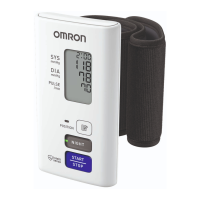
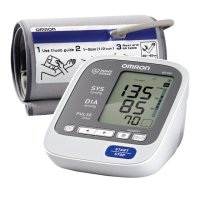
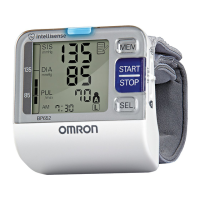

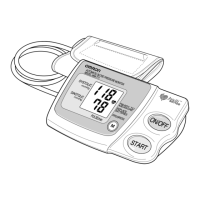
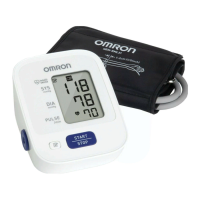
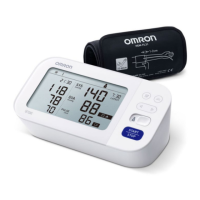
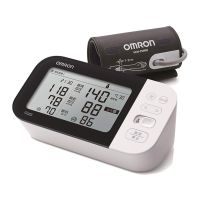
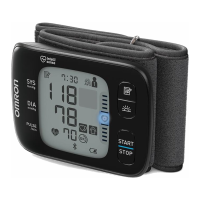
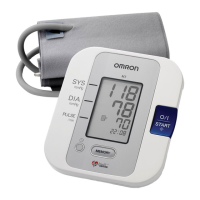
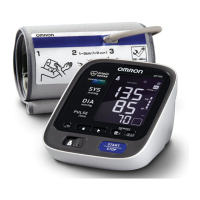
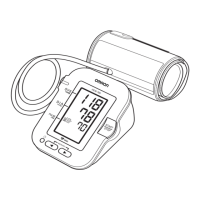

